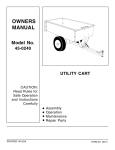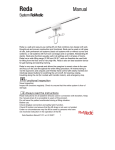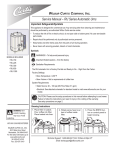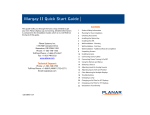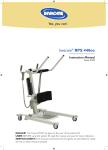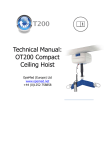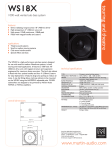Download Rena 3.0 MB - handicareproducteducation.com
Transcript
Rena 440/600 9 1 4 12 2 5 6 13 14 Rena440/600EE Rena440EM Rena440/600DS 1. Boom 2. Mast 3. Handlebar 4. Battery pack 5. Emergency stop 6. Control box 7. Motor for base-width adjustment 8. Rear castors with brakes 9. SlingBar with safety latch 10. Front castors 11. Emergency lowering (mechanical) 12. Motor/actuator for boom 13. Padded leg support 14. Foot rest 3 11 Manual 7 8 10 Rena 440 EM/EE/DS Max. load: 205 kg / 440Ibs Rena 440 is a mobile sit-to-stand lift that has been developed for use in combination with the correct lifting accessories to help the patient to stand up comfortably from a seated position. It provides support under the feet, against the shins and behind the back. Rena 440 is used in combination with StandUpSling. RoMedic’s slings and lifts are part of the SystemRoMedic concept, which takes a holistic approach to patient transfers. SystemRoMedic has four categories: transfer, repositioning, support and lifting. Functional inspection Visual inspection Inspect hoist functions regularly. Check to ensure that material is free from damage. Always read the instructions Read instructions for all assistive devices used in connection with transfers. Keep the manual where it is accessible to users of the product. Do not leave the patient unattended during a lifting situation. Before use: Make certain the lift is properly assembled. Lifting accessories must be properly trial fitted and tested in relation to the patient’s needs and functional ability. Check Slingbar connection and safety latch function. Check lift lifting function and base-width adjustment. Under no circumstances may the lift be used by persons who have not received instruction in the operation of the lift. Version 3.0d Table of Contents Safety Instructions Product Description Technical Data Measurements 440 series Measurements 600 series Final Inspection User's Guide Charging the Batteries Accessories Simple Troubleshooting Care and Maintenance Scale (on DS model only) 3 3 4 5 6 7 8 9 10 11 12 13 Note: In this document, the person being lifted is called the “patient" and the person helping is called the “caregiver". “Warning!” This instruction guide contains information that is important for users of the product. A complete understanding of the contents of the instruction guide is essential, and only personnel who are well informed should use the equipment. Remember to keep the instruction guide readily accessible for users of the product. VER 3.0D 2 07/2009 Safety Instructions Before use make certain that: • the lift is assembled according to the instructions. • the lifting accessories are properly mounted on the lift. • all instructions for both lift and accessories have been carefully studied and fully understood. • persons using the equipment have received appropriate instructions and training. • the appropriate lifting accessory regarding type, size, material and design in proportion to the patient is used following the sling manufacturers recommendations Maximum load: 440 lbs. (200 kg) Before lifting always make certain that: • • • • the back belt is not damaged. the patient is positioned firmly and securely so that no part of the body can be injured. the back belt is properly attached to the lift hook. This should be checked when beginning to lift the patient - when the sling straps are taut, but the patient is still seated. “Warning” Never leave the patient unsupervised in Rena! Product Description 1 12 2 13 3 14 4 15 5 16 6 17 7 18 8 9 19 10 11 VER 3.0D 1. Handcontrol 2. Lift Arm 3. Handles 4. Mast 5. Battery Pack 6. Emergency Stop Button 7 Control box with built-in charger 8. Label for color code sling sizes 9. Base spread handle 10. Rear castor with brake 11. Foot Tray, removable 12. Sling Bar Safety Latch 13. Lift Hook for back belt attachment 14. Emergency Lowering Device 15. Actuator for raising and lowering 16. Lower Leg Support, adjustable 17. Lower Leg Support adjustment knob 18. Calf support strap 19. Front castor 3 07/2009 Technical Data Lifting speed: 3,5 cm/s (1,4 inch./s) without load Batteries: Two 12V 2.9 Ah valve-regulated lead-acid gel-type batteries. Battery Built-in charger, 100-230 V, charger: max 400mA Actuator (mast): 24 V, 6 A, permanent magnetic actuator with mechanical safety mechanism and safety nut. Actuator (base): On EE/ DS models only-24 V, 3,5 A, permanent magnetic actuator. Material: Steel with hammer tone powder coat Emergency lowering: Mechanical and electrical Wheels: Front: 75 mm dual. Rear: 100 mm with brake. Intermittent Int. Op 10/90, active operation max 2 operation: min. Out of a time of 100, active must be less than 10, though not more than 2 min. Degree of protection: IP 43 Built for indoor operation. Type B according to the degree of protection against electric chock. Class ll equipment. VER 3.0D 4 07/2009 Measurements RENA 440 series RENA 440EM Row A B F E A RENA 440EE/DS B Row A B A 41.5 41.5 B 40.5 40.5 C 45 43.5 D 35 25.5 E 4.25 4.25 F 37.5 - 61 38 – 60.5 D C Note: Row A is measurements in inches, Row B is measurements in cm K RENA 440EM Row A I J G B Row A B G 21.5 - 37 20 – 30.5 H 26 1/2 - 42 24.25 - 35 I 15.5 15.5 J 3 1/2 4.25 K 18 18 * 108 lbs. 116lbs. * Weight of lift, A=lbs, B=kgs Note: DS models weigh 15 lbs. more H VER 3.0D RENA 44OEE/DS 5 07/2009 Measurements RENA 600 series RENA 600EM Row A B F E A RENA 600EE/DS B Row A B A 41 41 B 40 40 C 54 54 D 35.5 35.5 E 4.25 4.25 F 38.5 - 61 38.5 - 61 D C Note: Row A is measurements in inches, Row B is measurements in cm K RENA 600EM Row A RENA 600EE/DS B Row A B G 26.5 - 40 28.5 – 43 H 31.5 – 44.5 33.5 – 45 I 21.5 21.5 J 4 4 J K 18 18 G * 133.5 149.5 lbs. I H * Weight of lift, A=lbs, B=kgs Note: DS models weigh 15 lbs. more VER 3.0D 6 07/2009 Final Inspection • • • • • • • • • • Final inspection of the lift is required before putting the lift into service. Once the lift has been removed from it’s shipping pallet, inspect it for signs of damage. Make sure all four casters are working properly, check castor locks (figure 1) Inspect all connections, nuts and bolts. Look at the packing material to see if any loose nuts, bolts, screws are discovered. If any are found identify where they go and put them back on. Turn the emergency stop button clockwise so it pops out. (figure 2) Now the lift should be ready for operation. Take the hand control and push the up bottom. Run the lift arm all the way up. Then push the down button and run the lift all the way down. Verify the emergency stop button works by pushing it in and push the up or down button to verify the lift doesn’t work. Follow the instructions for a sling that you are using and lift a person (that is not a patient) in the lift to test operation. Verify that emergency lowering works with someone in the lift. (figure 3) If everything has checked out satisfactorily, plug the lift in for charging, verify the yellow charging light comes on. (figure 4) View the video in-service DVD for proper training on the Rino before you put the lift into use with a patient. VER 3.0D 7 1 2 3 4 07/2009 User’s Guide Operation • Operate the lift using the pushbuttons on the hand control. (figure 5) • For raising and lowering: Directional arrows show the direction of movement (up/down). The lift stops when you release the buttons. • For base-width adjustment: Press either of the two lower pushbuttons. Emergency Stop • To use the Emergency Stop: Push the red Emergency Stop button on the control box. (figure 6) • To reset: Turn the button in the direction of the arrows. Electrical emergency lowering • With a narrow object that is not sharp (a key or allen wrench), press the hole marked "EMERGENCY" on the control box. (figure 6, arrow is pointing at holes) Mechanical emergency lowering • Pull the red emergency lowering regulator upward one inch. (figure 7) The mechanical emergency lowering device functions only when the lift arm is loaded, i.e., when the patient is in the lift. Locking the wheels • To lock the wheels, press the brake lever above the wheel down with your foot. (figure 8) • During lifting, wheels should remain unlocked so that the lift may shift to the patient's center of gravity. The wheels should however be locked if there is a risk for the lift moving into the patient, for example when lifting from the floor. 5 6 7 8 9 Warning! Never move the lift by pulling the actuator! (figure 9) VER 3.0D 8 07/2009 Charging the batteries Battery Charge Level • Your Rena lift has three different indicators to alert you to the charge level of the batteries. One is a yellow LED light on the hand control. When it remains on when a button is depressed, the battery has less than 25% charge left. (figure 10) • The battery gauge is the best indicator of charge level. When less than 1 bar symbol, (figure 11) that indicates the charge level is below 25%. When the gauge appears like this it could also mean the emergency stop button is pushed in or the battery pack is not properly seated. • When all fields of the display are black, the battery is fully charged to 100%. • The third indication the battery is low is an audible beep as the lift is being operated. If you hear a beeping sound, the lift is below 25% charge level. Charging methods • Your Rena lift comes standard with a built- in charger. (figure 12) Simply plug it into a electrical outlet to charge. Verify the green LED light comes on to indicate the charger is receiving power. Verify the yellow LED is on indicating charging. Lock the wheels of the lift while it is charging. • An optional wall mounted charger is also available. (figure 13) Remove the battery from the lift and seat it on the wall mounted charger. Verify LED’s light as stated above. Notes • For maximum battery life, charge batteries often. • Don’t allow battery charge level to fall below 25%, it’s best to charge before the charge level reaches 50%. • Never charge in a wet area. • E-Stop button must be out to charge. VER 3.0D 9 10 11 12 13 07/2009 Accessories StandUp Slings • For Standup Slings and Accessories refer to the sling guide booklet. 14 Extra Battery Pack • Product number R9-321450, (figure 14) Good for emergency use or with the wall mounted charger for battery switching Wall Mounted Charger • Product number R9-14221 (figure 15) Mount on wall, preferably above a counter or service bench near an electrical outlet. It is recommended that wall mounted chargers be plugged into surge protecting power strips. StandUp Sling • The RoMedic StandUp Sling (Figure 16) comes in a variety of sizes from Small to XL. The StandUp sling comes with a safety strap and available synthetic sheepskin padding. Hygiene Sling • The Hygiene sling (figure 17) can be used with the Rena when the patient is unable or unwilling to bear weight. With the removal of the shin pad the rena safely lifts and transfers the patient in the hygiene sling to the commode from wheelchair or beside. See your RoMedic Representative for more information on this procedure. VER 3.0D 10 15 16 17 07/2009 Troubleshooting “The lift does not go up or down” “The lift goes up, but not down” (or vice a versa) 1. Check that the emergency stop button is not pushed in. 2. Check that the cables are connected correctly and pushed in all the way. 3. Check that the charging cable is not connected to the wall socket. The lift will not work when plugged in. 4. Check that the battery is charged. 5. Check that the battery is seated properly, take it off and re-seat it. 6. If the lift still does not work, contact RoMedic distributor. 1. Check that the cables are connected correctly and pushed in all the way. The hand control cable can appear to be in but if it is not seated all the way, one of the functions may not work. If you are not sure, pull it out and push it back in firmly. 2. If lift still does not function correctly, call your RoMedic distributor. “The legs of the lift won’t operate or only go one way. 1. Check that the cables are connected correctly and pushed in all the way. The hand control cable can appear to be in but if it is not seated all the way, one of the functions may not work. If you are not sure, pull it out and push it back in firmly. 2. If lift still does not function correctly, call your RoMedic distributor. “The lift stopped in the raised position.” 1. Check that the emergency stop button position has not been accidentally pushed in. (see page 7, figure 6) 2. Check the battery gauge to be sure lift is charged. (page 8, figure 12) If not switch with a charged battery. 3. If steps 1 & 2 failed and you have a patient in the lift, use the emergency lowering device to lower the patient safely to a bed or chair. (see page 7, figure 6 & 7) 3. If lift still does not function correctly, call your RoMedic distributor. “The lift is making a strange noise.” VER 3.0D 1. See if you can determine where the noise is coming from, take the lift out of use and call your RoMedic distributor. 11 07/2009 Care and Maintenance For safe and trouble-free operation, a few routine procedures should be performed every day the lift is used. • Visually inspect the patient lift and check for external damage or wear. • Check that all screws and lock nuts on the slingbar are tight. • Check that the safety latches on the slingbar are on and work properly. • Check the handcontrol and the lift and width movements. • Check the emergency lowering function (both electrical and mechanical). • Charge the battery every day the lift is used, and check charger function. If needed, clean the lift with warm water or mild soap solution. Warning! Do not use chemicals containing phenol or chlorine, since this may damage the aluminum materials. Inspection The lift must be thoroughly inspected at least once per year. Pay particular attention to parts that show wear, for example, joints, bolts, etc. Service must be carried out according to RoMedic service manual and by authorized personnel. IMPORTANT! Repairs and maintenance may only be carried out by qualified service personnel using original RoMedic replacement parts or equivalent. Transportation and storage During transportation, or when the patient lift is not to be used for some time, the emergency stop button should be pushed in. Store the lift at a temperature above the freezing point and at normal relative humidity (no more than 60%). Service agreements RoMedic recommends you to consider a service agreement for regular maintenance and testing of your RoMedic mobile lift. Contact your local RoMedic representative for more information. RoMedic’s products are constantly being updated and refined. RoMedic reserves the right to change aspects of the products without prior notice. Contact your local RoMedic representative for the latest information and advice. Made in USA RoMedic Rena lifts are manufactured according to CE standards and the Linak components meets the CE and UL standards. Contact RoMedic RoMedic, Inc. PO Box 388 Ephrata, PA 17522 www.romedic.com VER 3.0D Toll Free: Phone: Facsimile: E-mail: 888.625.4343 717.733.1444 888-691-1091 [email protected] 12 07/2009 Scale Scale Operation • • • Hang the back belt on the lift arm and press the ON/ZERO button to start or zero the scale. (figure 19) You will see the word “Zero” then it will count backwards- 3-2-1 and end at 0.0. Now place the backbelt on the patient properly and stand them with their feet on foot tray. If the scale has turned of just push the ON/ZERO button again. When patient is still the weight will record and the word “hold” will appear in the lower left corner of the display. When weighing is complete lower patient. • Notes • To change the mode from lb. Kg. Or kg to lb. Press the LB/KG button (it will read “conv”) and hold until the display flashes. Release the button. (figure 20) • If the display flashes with a weight, this indicates that a negative weight is being registered. • Display turns off after one minute of inactivity. • Press the recall button to display the last weight taken (over 50lbs / 22kg.). (figure 20) • Scale capacity is determined by weight capacity of lift, Rena 440 is 440lbs., Rena 600 is 600lbs., do not exceed capacity of lift. Batteries • The scale operates on 4 AA batteries. • To replace batteries locate battery cover on the underside of the scale. • Press the side tabs of the battery holder to release and pull out. • Replace all 4 AA batteries with new AA batteries and reassemble. Do not mix types of batteries (alkaline and standard) or old batteries with new batteries. VER 3.0D 13 18 19 21 07/2009














